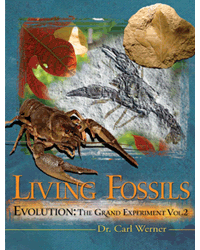This set is actually the second volume in the Evolution: The Grand Experiment series. We already owned the first set (including the DVD) and had used that rather loosely a couple of years ago. I was really excited to get a look at the second volume, and since I have more kids actually old enough to appreciate this now, I wondered how it would work for us now.
Here is what the publisher has to say about this book:
In 1938, the discovery of a large, unusual fish turned the scientific community on end. Dubbed a "living fossil," the discovery of a coelacanth in South Africa shocked scientists around the world who thought this type of fish had died out millions of years prior during the process of evolution. Today, living fossils are organisms preserved in the fossil record that still exist in similar form today. Their existence challenges the core concepts of evolution and create a fascinating debate among scholars. Do they indicate a younger earth than some have thought, placing the millions-of-years evolutionary timeline into question? Or do living fossils represent a deep mystery? Living Fossils, Vol. 2, Evolution: the Grand Experiment delves into these provocative questions. Includes 700 color images presented in an easy-to-read format. Ideal as a standalone study unit for schools and homeschoolers or easily integrated into existing curricula.Our take?
This is a LOT more textbook-y than we usually prefer before high school. And this was being used for my three oldest -- ages 10, 12 and 14. Connor is used to a textbook, but the other two really aren't. To be fair, the recommended grade level for this book is Middle School and High School -- so it isn't intended as a book for 10 year olds.
But it worked.
The book consists of 25 chapters, with most chapters being around 5-7 pages. There are a few that are significantly longer than that. The first three chapters are fairly text-heavy -- introducing the subject, and including a few relevant photos.
After that, though, most of the pages contain photos and not so much text. The photography is beautiful. My kids loved sitting and looking through the pictures. A lot of what is shown will be a fossil of some sort right next to a photo of the modern "equivalent" creature or plant.
The Teacher's Manual was useful, and would be even moreso if you wanted to give high school credit for this course. I opted not to. How I used the Teacher's Guide was:
- I read the "Purpose of the Chapter" statement aloud to the kids.
- We discussed the discussion questions, and for the most part really liked this.
- Then we read the chapter in the book. Aloud. And we pored over the photos.
- We discussed the "Objectives" listed in the Teacher's Manual
- Finally, we *orally* went through the chapter test
Disclaimer: I received this set of books for free from New Leaf Publishing Group. No other compensation was received. The fact that I received a complimentary product does not guarantee a favorable review.

No comments:
Post a Comment